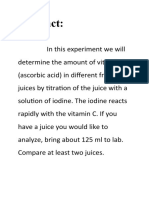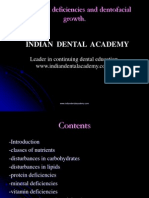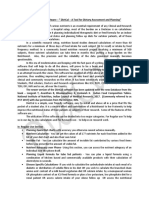Experiment 6.2
Experiment 6.2
Uploaded by
cindy_lee_11Copyright:
Available Formats
Experiment 6.2
Experiment 6.2
Uploaded by
cindy_lee_11Copyright
Available Formats
Share this document
Did you find this document useful?
Is this content inappropriate?
Copyright:
Available Formats
Experiment 6.2
Experiment 6.2
Uploaded by
cindy_lee_11Copyright:
Available Formats
Experiment 6.
2: Determining the vitamin C content in various food juices Purpose: To determine the vitamin C content in various food juices Problem statement: Do different types of fruit juices contain similar amounts of vitamin C? Hypothesis: Lime juice contains a higher concentration of vitamin C compared to orange juice. Variables: Manipulated variable : Type of fruit juices Responding variable : Volume of fruit juice needed to decolourise DCPIP solution Control variable : Volume of DCPIP solution, standard concentration of ascorbic acid solution Materials: 1.0% dichlorophenolindophenol (DCPIP) solution, 0.1% ascorbic acid solution, freshly prepared lime juice and orange juice. Apparatus: Specimen tubes, syringe (1ml), syringe (5ml), beakers (50ml), gauze cloth Technique: Measure and determine the volume of standard vitamin C solution/ fruit juices needed to decolourise of 1ml of DCPIP. Calculate the vitamin C content of juice by comparing it with the standard vitamin C solution. Procedure: Diagram showing the set-up of apparatus
1. 2. 3. 4.
1 ml of DCPIP solution is filled in a specimen tube using a 1 ml syringe. The 5 ml syringe is filled with 0.1% ascorbic acid solution. The tip of the syringe is placed into the DCPIP solution. The ascorbic acid solution is added to the DCPIP drop by drop. The mixture is gently stirred with the tip of syringe. The ascorbic acid solution is continuously added until the DCPIP solution is decolourised. The volume of ascorbic acid solution used is recorded. 5. Steps 1 to 4 are repeated for another two times. 6. Steps 1 to 5 are repeated using freshly squeezed lime juice and orange juice. The volume of fruit juice required to decolourise the DCPIP solution in each case is recorded in the table. 7. The results are tabulated. The percentage and the concentration of vitamin C in each of the fruit juices is calculated using the formulae below: Percentage of vitamin C in fruit juice = Volume of 0.1% ascorbic acid solution x 0.1 Volume of fruit juice Results: Concentration of vitamin C in fruit juice = Volume of 0.1% ascorbic acid solution Volume of fruit juice
x 1.0 mg cm-3
Results: Solution/ fruit juice Volume of solution/ fruit juice decolourise 1 ml of DCPIP solution 1 2 3 1.0 1.0 needed to Percentage of vitamin C in fruit Average juice (%) 1.0 Vitamin C concentration in fruit juice (mg cm-3)
0.1 % 1.0 ascorbic acid Lime juice Orange juice Discussion:
1. Oxidation of vitamin C in juices causes the DCPIP solution to decolourise. / Vitamin C reduces blue DCPIP to become colourless. 2. The specimen tubes containing the DCPIP solution should not be shaken when the ascorbic acid solution and the fruit juices are being added. This is because oxygen from the atmosphere oxides the reduced DCPIP solution and turns it blue again.
More fruit juice is needed to reduce the DCPIP solution. Hence, accuracy of the experiment is affected since the actual vitamin C content cannot be determined. 3. Lime juice contains the highest concentration of ascorbic acid/ vitamin C. In this experiment, less volume of fruit juice is needed to decolourise DCPIP if the vitamin C content is higher. 4. The vitamin C in the fruit juice is destroyed if the fruit juice is prepared a day earlier. 5. In order to maintain the vitamin C concentration in canned fruit juice, the can is sterilized under high pressure and high temperature. Conclusion: Hypothesis is accepted. Lime juice contains a higher concentration of vitamin C compared to orange juice.
You might also like
- V Rangarajan & T V Padmanabhan - Textbook of Prosthodontics - 2nd Edition (2017) - WWW - Thedentalhub.org - inDocument3,265 pagesV Rangarajan & T V Padmanabhan - Textbook of Prosthodontics - 2nd Edition (2017) - WWW - Thedentalhub.org - injayanti aneja75% (20)
- Vitamin C Content in Fruit JuicesDocument2 pagesVitamin C Content in Fruit JuicesSharifah Nurain100% (3)
- Lab Report - Vitamin CDocument10 pagesLab Report - Vitamin C>2350% (2)
- Experiment 4 Rat RespiratoryDocument5 pagesExperiment 4 Rat RespiratoryMuhammad Safwan100% (3)
- Vitamin C Core Practical Write Up PDFDocument2 pagesVitamin C Core Practical Write Up PDFMichael Collin0% (1)
- STPM 2013 Chemistry Coursework (Food Dyes)Document21 pagesSTPM 2013 Chemistry Coursework (Food Dyes)Michelle Lee Sze Yee100% (1)
- Experiment 3Document5 pagesExperiment 3Ji Sian LeeNo ratings yet
- Proposal For Chemistry Project STPM 2021Document2 pagesProposal For Chemistry Project STPM 2021Cherry T CYNo ratings yet
- Chemistry Project STPM On Vitamin CDocument3 pagesChemistry Project STPM On Vitamin CNarmeenNirma100% (1)
- Biology Coursework STPM 2020 Experiment 16 Title: Ecological Study of A Terrestrial Habitat ObjectiveDocument8 pagesBiology Coursework STPM 2020 Experiment 16 Title: Ecological Study of A Terrestrial Habitat ObjectiveEcikkNo ratings yet
- STPM Chemistry Term 1 Topic 6A Chemical EquilibriumDocument23 pagesSTPM Chemistry Term 1 Topic 6A Chemical EquilibriumChris Lau100% (7)
- The Vitamin C Content of Fruit JuiceDocument16 pagesThe Vitamin C Content of Fruit JuiceTootsie88% (40)
- Fluid Electrolyte Balances and ImbalanceDocument157 pagesFluid Electrolyte Balances and ImbalanceManisha Shakya0% (1)
- Carbonated Soft Drinks Powder 1Document44 pagesCarbonated Soft Drinks Powder 1fms162100% (3)
- Experiment 1Document2 pagesExperiment 1BumMe WoopNo ratings yet
- Do Oranges Lose or Gain Vitamin C After Being PickedDocument8 pagesDo Oranges Lose or Gain Vitamin C After Being Pickedrac_shetty15920% (2)
- Experiment 5 ChemistryDocument3 pagesExperiment 5 ChemistryJack OngNo ratings yet
- Project Report Chemistry (MAIN BODY)Document16 pagesProject Report Chemistry (MAIN BODY)Ung Hie HuongNo ratings yet
- PROPOSAL FOR CHEMISTRY PROJECT STPM 2023 New-1Document6 pagesPROPOSAL FOR CHEMISTRY PROJECT STPM 2023 New-1Thurgahini KikaNo ratings yet
- Experiment Kimia 1Document7 pagesExperiment Kimia 1Aq Nadzrul Larh88% (8)
- Experiment 4 (Biology)Document11 pagesExperiment 4 (Biology)言爱邦0% (1)
- STPM Biology Past Year QuestionDocument8 pagesSTPM Biology Past Year QuestionMc Donalds Ohl Ohlsen100% (2)
- Proposal For Research On Vegetable Dyes On ClothingDocument6 pagesProposal For Research On Vegetable Dyes On ClothingLeeWTTheresa100% (1)
- Experiment 3-Volumetric Analysis - Purity and Stoichiometry Hanif MenhadDocument8 pagesExperiment 3-Volumetric Analysis - Purity and Stoichiometry Hanif MenhadFoo Chee HengNo ratings yet
- Experiment 1 2015Document4 pagesExperiment 1 2015UngHHNo ratings yet
- 2021 STPM 954-P1 AnsDocument5 pages2021 STPM 954-P1 AnsPavitraNo ratings yet
- Trial STPM Chemistry Sem 1 PDFDocument7 pagesTrial STPM Chemistry Sem 1 PDFsuhaidah47100% (1)
- STPM Sem 3 Chemistry Note - Chapter AlkanesDocument21 pagesSTPM Sem 3 Chemistry Note - Chapter AlkanesSTPMBAHARU100% (3)
- STPM BIOLOGY Control in CellsDocument35 pagesSTPM BIOLOGY Control in Cellswkwhui100% (1)
- First Term STPM BIology Trial (2015-2Document11 pagesFirst Term STPM BIology Trial (2015-2Then Moli50% (2)
- STPM Chemistry Form 6 Definition ListDocument16 pagesSTPM Chemistry Form 6 Definition ListCherry T CY100% (1)
- Rat ExperimentDocument7 pagesRat ExperimentKavithaa Sengalrayan0% (1)
- Chemistry Sem 1 Short NoteDocument63 pagesChemistry Sem 1 Short NoteNasi KalapaNo ratings yet
- Sem 1 2022 Manual ChemistryDocument9 pagesSem 1 2022 Manual ChemistryVZYFVVZHVMNo ratings yet
- 962 Chemistry (PPU - STPM) Semester 3 Topics-SyllabusDocument13 pages962 Chemistry (PPU - STPM) Semester 3 Topics-SyllabusJosh, LRTNo ratings yet
- STPM 2022 Sem 3 Mock AnsDocument2 pagesSTPM 2022 Sem 3 Mock Ansg-65251693100% (1)
- Biology 2008 STPMDocument18 pagesBiology 2008 STPMtecklee89100% (6)
- STPM 2009Document19 pagesSTPM 2009one kilometer100% (2)
- Answer Scheme Chemistry P1 2022 Set 1Document6 pagesAnswer Scheme Chemistry P1 2022 Set 1Tan JennyNo ratings yet
- STPM Physics Chapter 15 Direct Current CircuitsDocument1 pageSTPM Physics Chapter 15 Direct Current CircuitsChris Lau100% (1)
- STPM 2016 Physics 1Document16 pagesSTPM 2016 Physics 1Abdul ShariffNo ratings yet
- Vitmin C ReportDocument14 pagesVitmin C ReportOdongo TonnyNo ratings yet
- EXP 5 Determination For Ascorbic Acid AnalysisDocument2 pagesEXP 5 Determination For Ascorbic Acid AnalysisthirafauziNo ratings yet
- STPM Baharu 2014 Sem 2 (Mathematics T 954)Document21 pagesSTPM Baharu 2014 Sem 2 (Mathematics T 954)Alex TanNo ratings yet
- Trial STPM Physics Term 1 2015Document11 pagesTrial STPM Physics Term 1 2015Marce La50% (2)
- Chemistry - Semester 1 - Experiment 1Document3 pagesChemistry - Semester 1 - Experiment 1Rawid GoshanNo ratings yet
- STPM Physics 2008Document26 pagesSTPM Physics 2008Tang Siew Eng100% (2)
- Experiment 5 Chemistry Form 6Document3 pagesExperiment 5 Chemistry Form 6Fu Hong100% (10)
- Trial STPM Term1 2017Document12 pagesTrial STPM Term1 2017Earliany Mohd ShahriNo ratings yet
- Lesson 41Document4 pagesLesson 41MarcTnn100% (1)
- STPM 2021 Sem 3 Mock AnsDocument2 pagesSTPM 2021 Sem 3 Mock AnsNATASHA NADIA BINTI ABDULLAH MoeNo ratings yet
- STPM 2020 Sem 1 Mock AnsDocument2 pagesSTPM 2020 Sem 1 Mock AnsNicole LimNo ratings yet
- Analysis Benzoate On Tomato SauceDocument6 pagesAnalysis Benzoate On Tomato SauceSuplier WallpaperStiker Dan SabunHerbal100% (1)
- L STPM 2019 SEM 1 MOCK ANSDocument2 pagesL STPM 2019 SEM 1 MOCK ANSm-7319562100% (1)
- Experiment 2: RedoxDocument1 pageExperiment 2: RedoxFu HongNo ratings yet
- Chapter 6 - Nutrition (Vitamin C)Document2 pagesChapter 6 - Nutrition (Vitamin C)Raja Marina IraniNo ratings yet
- AbstractDocument17 pagesAbstractRukmani 1011No ratings yet
- Exp 6.3 (Form 4)Document2 pagesExp 6.3 (Form 4)IMELDANo ratings yet
- DCPIPDocument6 pagesDCPIPgabNo ratings yet
- Biology Plan and Design Vitamin CDocument4 pagesBiology Plan and Design Vitamin CEliana SomanNo ratings yet
- Chapter 6 - Nutrition (Vitamin C)Document2 pagesChapter 6 - Nutrition (Vitamin C)Abdullah Yusof AzzamNo ratings yet
- PKS A f4 VITAMIN CDocument4 pagesPKS A f4 VITAMIN CSK Pos Tenau100% (1)
- Apple Cider Vinegar Recipes: Easy Apple Cider Recipes to Lose Weight Fast, Boost Energy Levels and Live HealthyFrom EverandApple Cider Vinegar Recipes: Easy Apple Cider Recipes to Lose Weight Fast, Boost Energy Levels and Live HealthyNo ratings yet
- Malnutrition NoteDocument2 pagesMalnutrition Notecindy_lee_11No ratings yet
- Experiment 6.1Document3 pagesExperiment 6.1cindy_lee_1175% (4)
- Simulation and ModelingDocument7 pagesSimulation and Modelingcindy_lee_11No ratings yet
- PBL Plant AdaptationDocument55 pagesPBL Plant Adaptationcindy_lee_11No ratings yet
- DipterocarpaceaeDocument23 pagesDipterocarpaceaecindy_lee_11No ratings yet
- Glatz Sustainable Small-Scale Poultry Production Are Local Feeds A Viable Option For The Pacific RegionDocument10 pagesGlatz Sustainable Small-Scale Poultry Production Are Local Feeds A Viable Option For The Pacific RegionEddy MwachenjeNo ratings yet
- HealthifyPro LITE Information CollateralDocument11 pagesHealthifyPro LITE Information CollateralAdnan SabirNo ratings yet
- Community ImmersionDocument3 pagesCommunity ImmersionMikhaela CoronelNo ratings yet
- Daftar PustakaDocument2 pagesDaftar PustakaRomario AbdullahNo ratings yet
- Hypothyroidism Nursing Care PlanDocument3 pagesHypothyroidism Nursing Care PlanRizza Mae Maglacion100% (1)
- Nutri-Quiz ReviewerDocument6 pagesNutri-Quiz ReviewerJonel TorresNo ratings yet
- Breville BM600Document68 pagesBreville BM600nochua5864No ratings yet
- Neurobehavioral Effects of Aspartame ConsumptionDocument9 pagesNeurobehavioral Effects of Aspartame ConsumptionElitaFebySusantoNo ratings yet
- So More of This IshDocument8 pagesSo More of This IshRashalee GayleNo ratings yet
- Evaluation Form: Quirino State UniversityDocument12 pagesEvaluation Form: Quirino State UniversityQUEENIE JAM ABENOJANo ratings yet
- Analisis HPLC Vitamin KDocument3 pagesAnalisis HPLC Vitamin KDiana Agustini RaharjaNo ratings yet
- How To Stay HealthyDocument2 pagesHow To Stay HealthyMissdiary Rahman100% (1)
- Nutritional Deficiencies and Dentofacial Growth / Orthodontic Courses by Indian Dental AcademyDocument86 pagesNutritional Deficiencies and Dentofacial Growth / Orthodontic Courses by Indian Dental Academyindian dental academyNo ratings yet
- General Sports KnowledgeDocument7 pagesGeneral Sports KnowledgeAbbyNo ratings yet
- Kuesioner KAPDocument3 pagesKuesioner KAPmorning GloryNo ratings yet
- RMDocument40 pagesRMIrish Pauline L. EreñoNo ratings yet
- Eating Healthy FoodDocument2 pagesEating Healthy Foodnishitapatel024No ratings yet
- AbecedinDocument2 pagesAbecedinmohammadNo ratings yet
- Dietary Reference Values - A Guide 1991Document58 pagesDietary Reference Values - A Guide 1991Ceutico ConsultingNo ratings yet
- 1-Salient Features and List of Users of DietCalDocument5 pages1-Salient Features and List of Users of DietCalBarbie mendroliaNo ratings yet
- G2 BTLED Acceptability of Vacuum Fried Squash Cucurbita Maxima Chips With Different Flavors. FinalDocument28 pagesG2 BTLED Acceptability of Vacuum Fried Squash Cucurbita Maxima Chips With Different Flavors. FinalMyka Mae Edep LasernaNo ratings yet
- 99 Weight Loss Questions Answered 1 PDFDocument54 pages99 Weight Loss Questions Answered 1 PDFjasmineNo ratings yet
- Saba BegumDocument4 pagesSaba Begumdatabase.mnrsolutionsNo ratings yet
- Nutrition During PregnancyDocument5 pagesNutrition During PregnancyAbdulsalamNo ratings yet
- Management Guide: For Laying Hens in Deep Litter, Perchery and Free-Range SystemsDocument34 pagesManagement Guide: For Laying Hens in Deep Litter, Perchery and Free-Range SystemsSri PurwantiNo ratings yet
- SAMPLE RobRiches UltraLeanDocument16 pagesSAMPLE RobRiches UltraLeanYair Rivera100% (2)
- Proximate Composition, Phytochemical and Elemental AnalysisDocument13 pagesProximate Composition, Phytochemical and Elemental AnalysisAlexander DeckerNo ratings yet






























































































